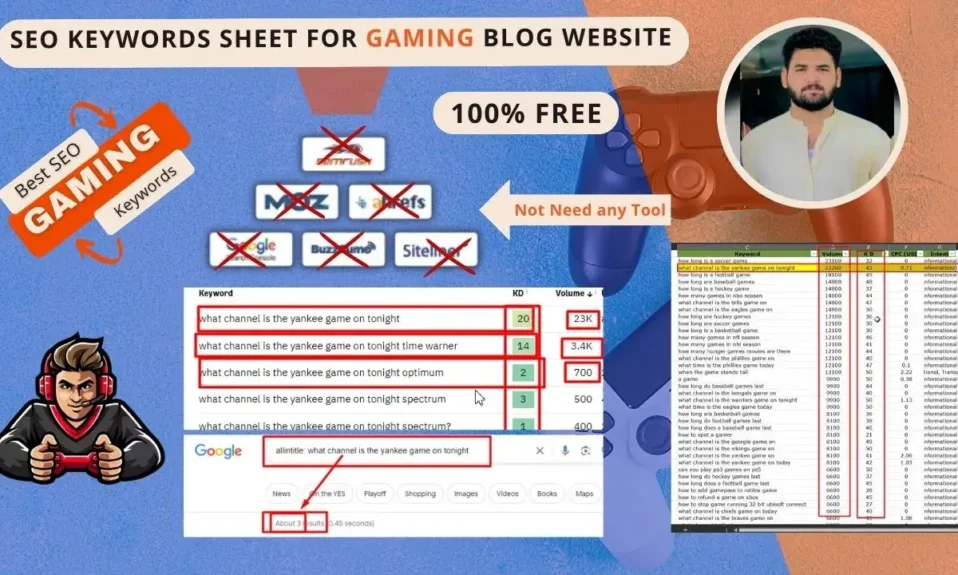
First Contentful Paint (FCP) is an online efficiency metric that measures how lengthy it takes for the primary aspect of a web page to be rendered and visual within the person’s browser.
Though FCP is just not a Core Net Vitals metric, you shouldn’t ignore it in case you care about your person expertise.
Why? As a result of quick FCP signifies that your customers can see that your content material is loading, and how briskly it’s taking place contributes to their satisfaction. And the extra happy your customers are, the extra keen they’re to remain in your web page, discover your content material, and convert.
With out additional ado, discover ways to measure and enhance your FCP rating to offer your web site’s guests with a optimistic expertise.
What does First Contentful Paint (FCP) imply?
First Contentful Paint (FCP) is a user-centric metric calculating the time it takes to render the primary content material aspect on a web page that’s loading in a browser.
In different phrases, FCP tracks the time between when a web page begins loading and when the primary content material aspect is seen within the person’s browser.
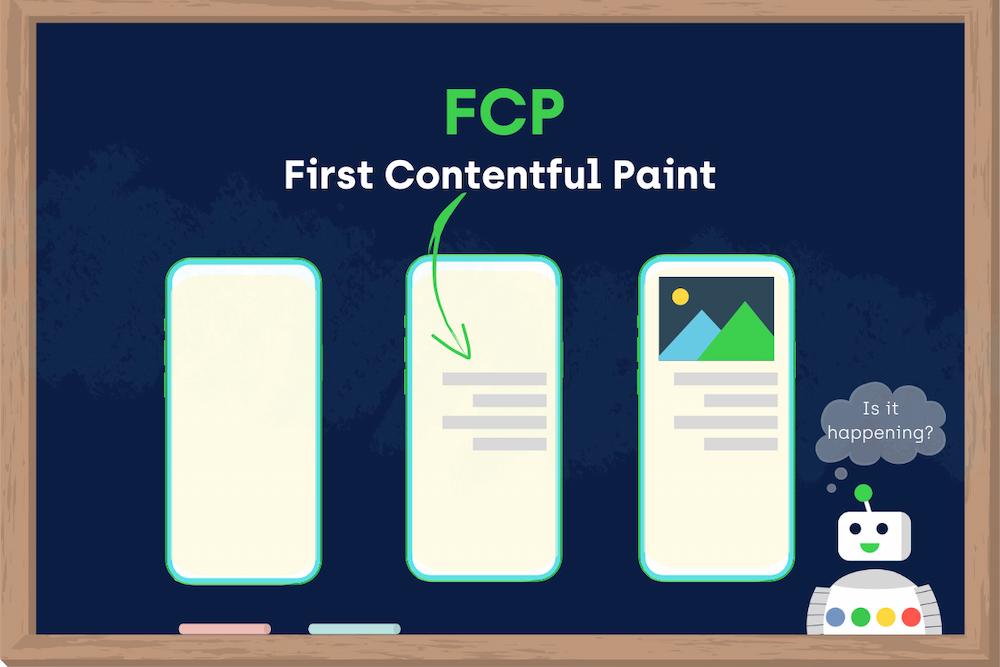
To be much more exact, FCP measures how lengthy it takes to render the primary Document Object Model (DOM) aspect that’s:
- textual content,
- picture (together with background photographs,)
- non-white <canvas> aspect, or
- <svg> aspect.
FCP is a vital metric from the UX perspective because it measures how actual customers understand the web page load and decides on the primary impression customers have of your web page.
For instance, think about customers ready too lengthy in your web page to load, seeing solely the default background.
How lengthy is ‘too lengthy’ for customers to get irritated and wish to exit a web page? Lengthy sufficient is when customers can already discover the delay.
Quick FCP signifies that ‘one thing’ is occurring within the background. In your customers, the primary aspect being rendered on the display displays that:
- the web page is working accurately, and
- there’s some content material on the web page customers might wish to additional discover and work together with.
From that perspective, FCP is a metric you shouldn’t ignore.
Tips on how to measure FCP?
First Contentful Paint (FCP) may be analyzed primarily based on field and lab data.
You might mix these two methods of measuring efficiency to make sure unbiased FCP outcomes.
Lab instruments
Lab information lets you measure your FCP rating in a check atmosphere with predefined settings.
The next instruments might help you monitor your FCP measured in a lab:
Chrome DevTools
To measure FCP in Chrome DevTools, open the ‘Efficiency’ part and click on the ‘Reload’ button to let the device analyze your web page.
To search out your actual FCP on the web page load timeline:
- go to the ‘Timings’ part, or
- tick the field containing ‘Net Vitals’ beneath the principle Chrome DevTools navigation bar and head to the ‘Net Vitals’ part on the timeline.
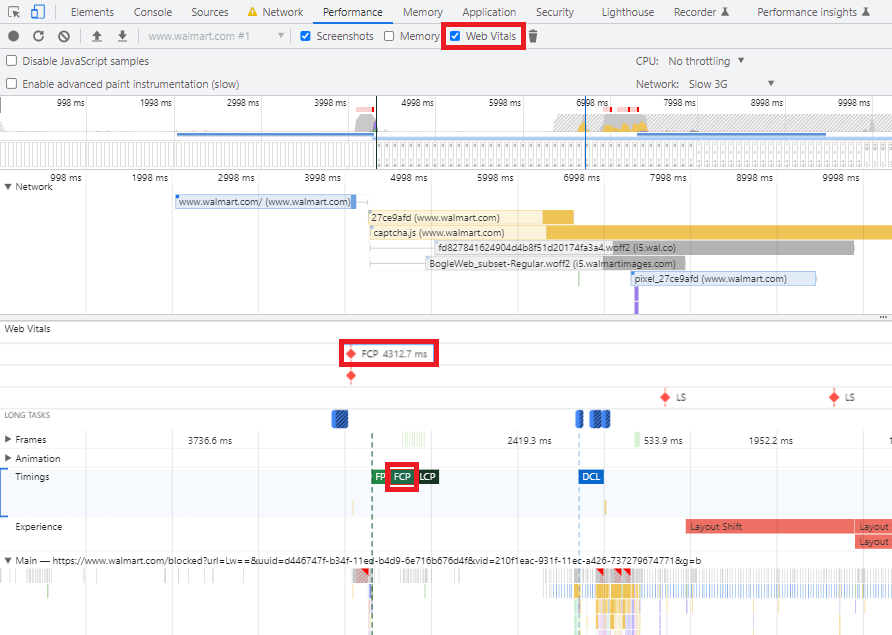
Lighthouse
To measure your FCP rating in Lighthouse, head to Chrome DevTools and open the ‘Lighthouse’ tab to run a efficiency audit.
Lighthouse will collect the information and generate the report outlining your FCP rating within the ‘Metrics’ part.
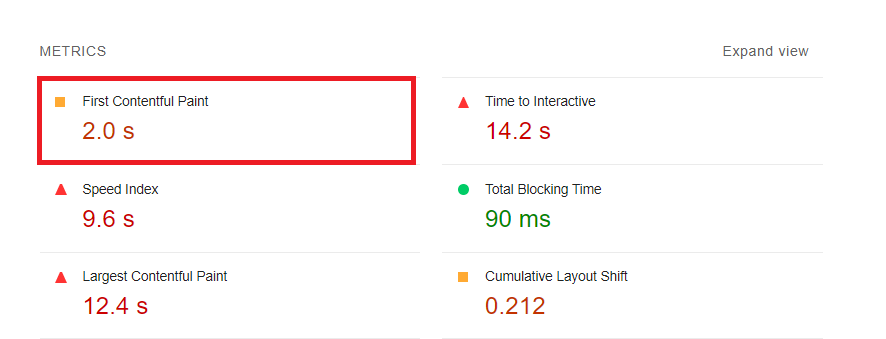
Furthermore, Lighthouse supplies particular recommendations on what you possibly can enhance for higher FCP. To see them, all you might want to do is to filter out the outcomes for FCP above the ‘Alternatives’ and ‘Diagnostics’ sections.
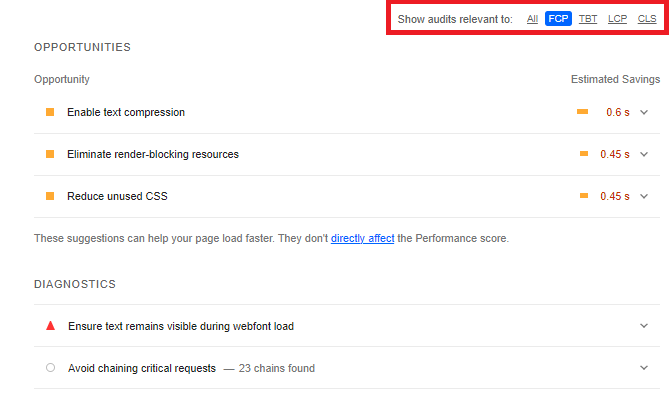
Subject instruments
To enhance your FCP rating for a greater person expertise, discipline information is a useful supply of data because it reveals how actual customers work together with web sites on the net.
The essential factor is that Google’s discipline information relies on the Chrome Person Expertise Report (CrUX), “used by Google Search to inform the page experience ranking factor.” Which means that by monitoring and optimizing the actual person information collected in CrUX, you possibly can immediately affect Google’s evaluation of how performant your pages are.
The next instruments might help you monitor your FCP primarily based on discipline information:
PageSpeed Insights
PageSpeed Insights combines lab and discipline information from Lighthouse and CrUX, respectively.
To measure FCP utilizing PageSpeed Insights, you simply must insert the URL you wish to analyze within the device’s search bar.
Aside from the Lighthouse lab information you can see within the ‘Metrics’ part, PageSpeed Insights lets you see how actual customers expertise the analyzed web page each on cellular and desktop gadgets.
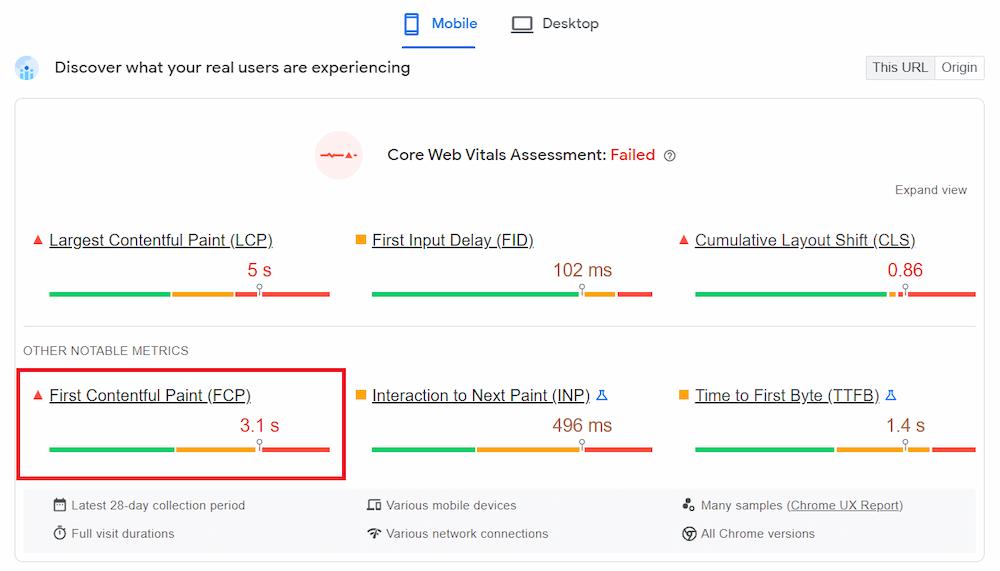
Additionally, equally to Lighthouse, PageSpeed Insights supplies detailed suggestions on bettering your FCP within the ‘Alternatives’ and ‘Diagnostics’ sections.
Chrome Person Expertise Report
Chrome Person Expertise Report (CrUX) represents how real-world Chrome customers expertise web sites on the net.
There are a number of methods to entry the CrUX information in your web site:
- Use the CrUX API. For those who don’t have expertise with APIs, seek the advice of your builders or comply with the official Google documentation on CrUX API.
- Create a Looker Studio CrUX dashboard utilizing a ready-made template. (this feature is beginner-friendly however doesn’t present granular information.
- Question the CrUX datasets using Google BigQuery.
JavaScript API
When you’ve got some expertise with utilizing JavaScript, you should utilize the Paint Timing API to seize FCP within the web page load.
Nonetheless, how the actual FCP metric is calculated and what the API reflects may differ. That’s why, to keep away from pointless confusion, Google recommends utilizing the web-vitals JavaScript library for measuring FCP.
However keep in mind that the web-vitals library also has its limitations. For instance, it’s unimaginable to measure cross-origin iframes in JavaScript whereas to calculate FCP you want to have the ability to measure all iframes.
What is a perfect First Contentful Paint rating?
As FCP measures the time it takes for the primary aspect of your web page to render and be seen on the display, the decrease your rating is, the higher, so that you present your web site’s guests with a optimistic searching expertise.
It means it is best to intention for an FCP rating of 1.8 seconds or much less. To be much more exact, Google advises having an FCP rating of 1.8 seconds or much less for 75% of all of your web page views.
To make sure you’re hitting this goal for many of your customers, an excellent threshold to measure is the seventy fifth percentile of web page hundreds, segmented throughout cellular and desktop gadgets.
Thresholds for First Contentful Paint
To get a greater understanding of your FCP rating, it is best to comply with the thresholds developed by Google.
Every FCP threshold is marked with a unique shade, making it simpler to interpret the rating utilizing numerous instruments.
Listed here are the precise thresholds specified for FCP values:
| FCP time | Tips on how to analyze your rating |
| 0-1.8 seconds | Good (inexperienced) |
| 1.8-3 seconds | Wants enchancment (orange) |
| Over 3 seconds | Poor (purple) |

To find out your FCP rating, Google compares your web page’s outcomes to the actual web sites’ information from the HTTP Archive.
What causes excessive First Contentful Paint?
The First Contentful Paint (FCP) rating could also be negatively affected by numerous components contributing to how briskly your assets may be loaded and rendered originally of web page load.
Nonetheless, among the many most typical causes of the excessive FCP rating, you could find:
- gradual server response time,
- render-blocking CSS and JavaScript assets,
- lazy loading above the fold,
- an extreme DOM dimension, and
- gradual font loading time.
Though understanding what facets might contribute to poor FCP is important, keep in mind that analyzing your FCP rating and figuring out the potential causes of your points is half the battle.
Why? As a result of solely an in-depth prognosis of your issues might help you effectively optimize your FCP for higher load pace and person expertise.
Subsequently, let’s dive into FCP optimization.
Tips on how to enhance First Contentful Paint?
To start with, chances are you’ll use the particular FCP suggestions included within the Lighthouse efficiency audit within the ‘Alternatives’ and ‘Diagnostics’ sections.
However, you may additionally wish to know what facets don’t should be additional optimized for a greater FCP rating. You could find this data in Lighthouse’s ‘Handed audits’ part.
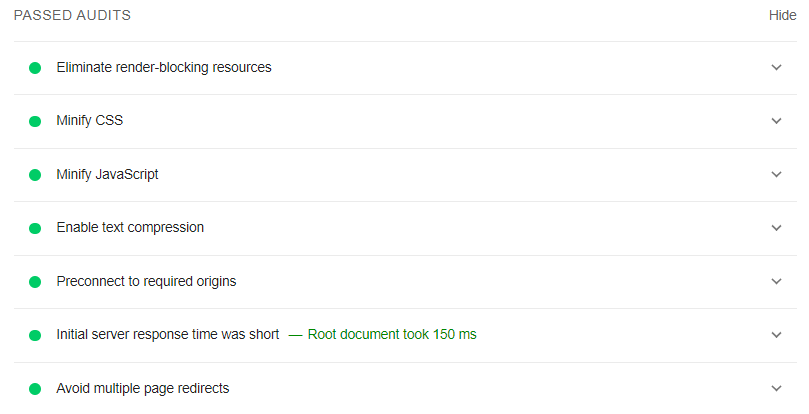
However usually, in line with Google’s official documentation, there are a number of methods of bettering FCP for any web site. Let’s dive in.
| Suggestions | Plan of motion |
| Eliminate render-blocking resources | Optimize the assets that block your web page’s first paint by delivering crucial CSS and JS inline, deferring non-critical assets, and eradicating unused ones. |
| Minify or take away unused CSS and JavaScript | Minify unused CSS and reduce JavaScript to attenuate assets consumed by the community exercise by, e.g., deferring non-critical CSS or utilizing code splitting. |
| Cut back server response time (TTFB) | Optimize Time to First Byte (TTFB) by, e.g., utilizing CDN internet hosting and repair employees. |
| Avoid multiple page redirects | Keep away from a number of redirect loops and chains to forestall attainable redirect errors and extra delays earlier than the web page may be loaded. |
| Preload key requests | Prioritize fetching assets which might be requested later within the web page load by utilizing <hyperlink rel =preload>. |
| Preconnect to required origins | Set up early connections to essential third-party origins by including preconnect or dns-prefetch useful resource hints. |
| Keep payload size down | Keep away from massive community payloads by deferring requests till they’re wanted, caching them, or utilizing WebP photographs as a substitute of JPEG or PNG. |
| Serve static assets using caching | Configure HTTP caching to hurry up the recurring visits to your web page by establishing your server to return the Cache-Management HTTP response header. |
| Avoid an excessive DOM size | Take away the unused DOM nodes and create new ones solely when wanted. If you have already got a big DOM tree, simplify your CSS selectors. |
| Minimize critical request depth | Cut back the variety of crucial assets, optimize their loading order, think about using the async or defer attributes, and optimize the variety of crucial bytes to scale back the obtain time. |
| Ensure text remains visible during webfont load | Guarantee textual content is seen to customers whereas fonts are loading. Keep away from a flash of invisible textual content (FOIT) by together with font-display: swap in your @font-face type. |
| Minimize request counts and payload sizes | Optimize your photographs and fonts, change GIFs with movies, optimize your third-party assets, and handle the render-blocking CSS and JS assets.
|
As you possibly can see, there are quite a few formally advisable methods by Google to optimize a poor FCP rating.
Nonetheless, as each web site is exclusive, solely an professional evaluation of your particular efficiency points might allow you to get to the actual reason for your issues and enhance your FCP rating.
That’s why, in case you don’t wish to undergo the optimization course of by your self, we are able to deal with it for you.
NEXT STEPS
Right here’s what you are able to do now:
- Contact us.
- Obtain a personalised plan from us to take care of your efficiency points.
- Take pleasure in your natural visitors that converts!
Nonetheless uncertain of dropping us a line? Examine how our web performance services might help you pace up your web site and enhance your perceived load pace.
First Contentful Paint vs. different internet efficiency metrics
First Contentful Paint isn’t the one metric measuring how briskly a web page’s parts render and cargo on the display.
Due to that, FCP is usually confused with different user-centric performance metrics, though they measure totally different facets of a web page’s efficiency.
Let’s dive in and evaluate FCP to different intently associated metrics.
First Contentful Paint vs. Largest Contentful Paint
Whereas First Contentful Paint (FCP) measures when the primary aspect on a web page renders, Largest Contentful Paint (LCP) calculates how lengthy it takes for the biggest aspect on a web page.
The essential factor to recollect right here is that the primary loaded aspect on a web page doesn’t must be the biggest one.
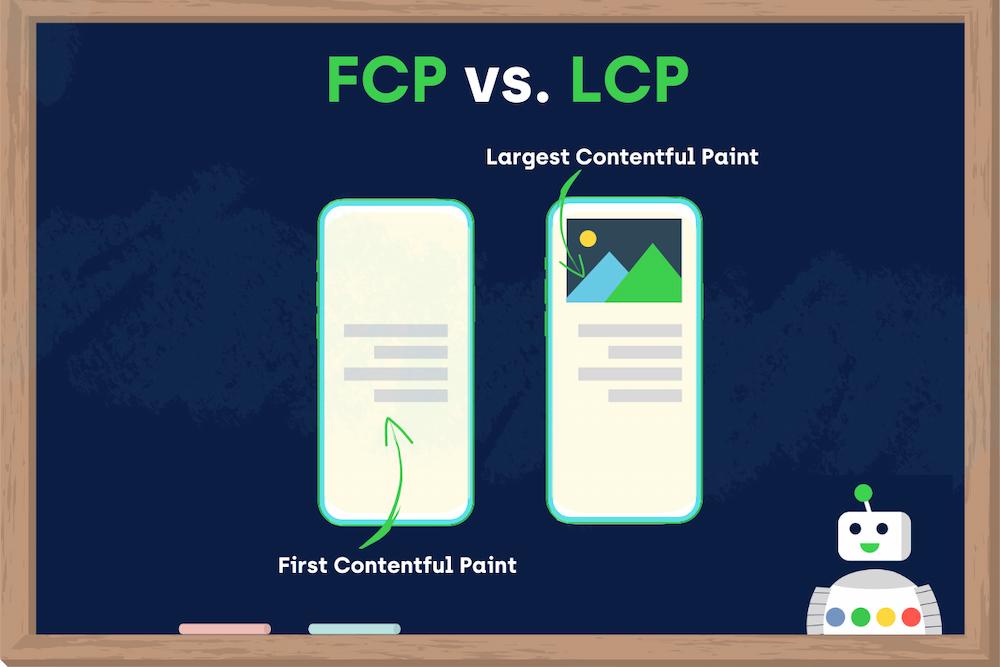
One other essential distinction is that LCP is among the Core Net Vitals — confirmed by Google rating components.
For extra particulars on this Core Web Vitals metric, learn our Largest Contentful Paint (LCP) article to be taught why it’s essential and the best way to optimize it.
First Contentful Paint vs. First Significant Paint
Versus First Contentful Paint (FCP) which measures when the primary aspect renders on a web page, First Significant Paint (FMP) calculates when the first above-the-fold content material of a web page is seen.
According to Google, FCP and FMP might equal when the primary rendered aspect on a web page constitutes the content material above the fold.
However, FCP and FMP will differ when the content material above-the-fold is situated inside an iframe, as FCP doesn’t measure it by default.
Nonetheless, an essential factor is FMP is now not used because the Lighthouse 6.0 model, and Google recommends utilizing LCP as a substitute.
First Significant Paint (FMP) is deprecated in Lighthouse 6.0. In observe FMP has been overly delicate to small variations within the web page load, resulting in inconsistent (bimodal) outcomes. Moreover, the metric’s definition depends on browser-specific implementation particulars, which implies it can’t be standardized nor applied in all internet browsers. Transferring ahead, think about using Largest Contentful Paint as a substitute.
supply:
Chrome Developers
First Contentful Paint vs. First Paint
Though First Contentful Paint (FCP) and First Paint (FP) appear to be similar, you shouldn’t use them interchangeably as they measure totally different facets of a web page’s perceived load pace.
FP calculates when the primary pixels render on the display contemplating the slightest adjustments, like altering the default background shade.
However, FCP measures the time when the primary DOM parts, like textual content or photographs, are already rendered.
To offer your customers with a optimistic person expertise, FCP and FP ought to happen concurrently in order that customers don’t really feel any delay.
First Contentful Paint vs. Time To Interactive
First Contentful Paint (FCP) and Time To Interactive (TTI) measure a web page’s perceived load pace and responsiveness, respectively.
So how do they relate? FCP helps you calculate (and optimize) your TTI rating as a result of FCP works as a place to begin to measure TTI.
In different phrases, if you wish to measure how lengthy it takes for a web page to develop into absolutely interactive (TTI,) you might want to begin counting it from FCP.
Learn our article about Time To Interactive (TTI) to discover ways to enhance it in your pages’ higher interactivity and responsiveness.
As you possibly can see, focusing solely on FCP might not be sufficient to completely enhance your web site’s efficiency and person expertise.
Figuring out the distinction and relationship between all these metrics above will enable you optimize your pages’ responsiveness and interactivity all through the web page load lifecycle.
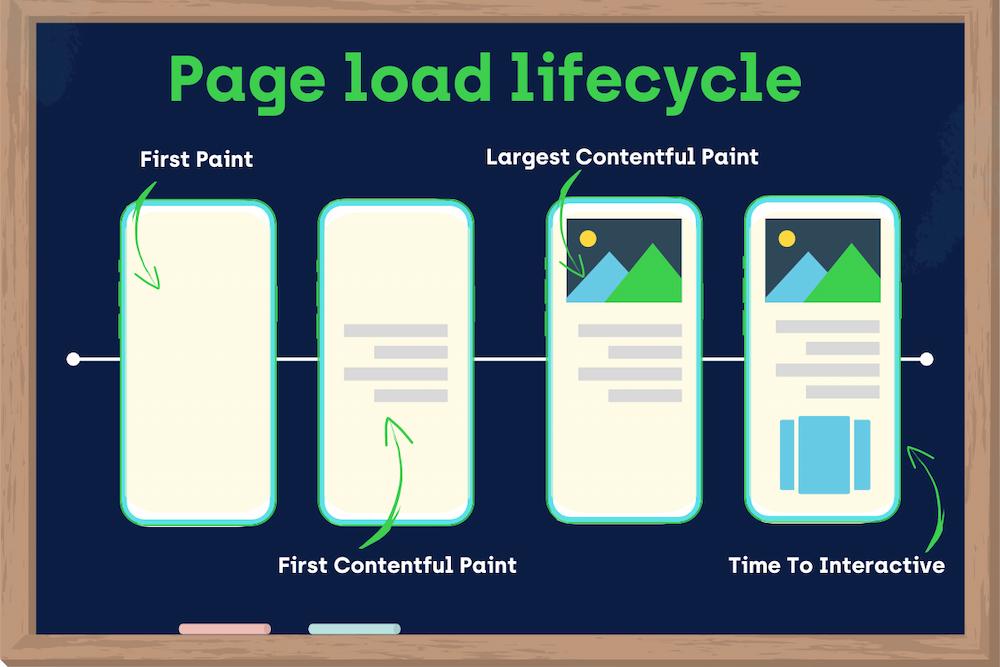
Learn our articles about different internet efficiency metrics:
Wrapping up
- First Contentful Paint (FCP) marks the time within the web page load timeline when the primary content material aspect is rendered and visual within the person’s browser.
- You need to intention for an FCP of lower than 1.8 seconds. Keep in mind that quick FCP makes a visual distinction to your customers and contributes to their searching satisfaction.
- The commonest causes of a poor FCP rating are render-blocking assets, gradual response time, and an extreme DOM dimension. Addressing these points will enable you pace up your pages and enhance your total FCP rating.
- Whereas FCP could also be confused with different internet efficiency metrics, understanding their variations might contribute to your FCP rating and yield higher efficiency outcomes in your web site.
- In 2023, when the significance of an excellent person expertise is plain, bettering FCP is now not a query of ‘if’ however ‘how’ to maximise your web page’s potential. Contact us to see how a personalised plan of motion in your web site can carry unparalleled search engine optimisation and enterprise outcomes.
#Optimize #Contentful #Paint #FCP #Person #Expertise






